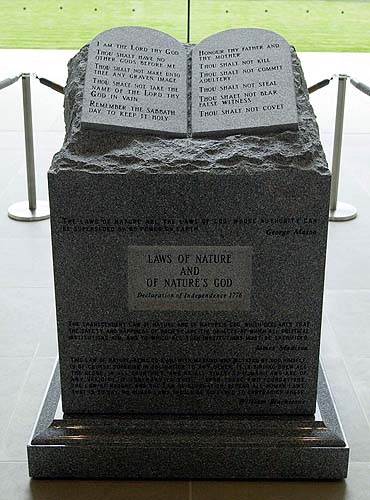 Are the Ten Commandments Really Carved in Stone?
Are the Ten Commandments Really Carved in Stone?
In Mel Brooks' "History of the World, Part I," Brooks, playing Moses, descends from Mt. Sinai after an encounter with God. Dressed like Charlton Heston, he carries three stone tablets down the mountain and announces to the assembled Israelites: "All pay heed! The Lord Jehovah has given unto you, these 15...."
One of the tablets slips from his hand and shatters at his feet. He stares for a moment. "Oy."
"Ten." Recovering quickly, he shouts, "Ten Commandments for all to obey."
Not to worry. Moses broke the first set too.
Mr. Brooks, meet Judge Roy Moore of the Alabama Supreme Court, who defied a federal court ruling to remove a two-and-a-half ton, jukebox-sized granite replica of the Ten Commandments from an Alabama courthouse. Moore was, last month, finally suspended from his office as chief justice of the court and became a hero to a segment of the evangelical Christian community, and to that part of Alabama's population not embarrassed by him. Observers say he will probably run for office.
The replica belongs to Moore personally, and thus won't be broken as were the tablets of Moses or Mel Brooks. But for those who believe Biblical religion to be the cornerstone of American civil life, and the Decalogue to be the cornerstone of Biblical religion, the tablets and their removal are both potent symbols. Yet in reality, the Ten Commandments are a far more contentious and ambiguous set of Biblical verses than Moore would like to believe. Really, what are the Ten Commandments?
Moore's Law
For Moore (who even the conservative National Review excoriated as an "oddball and a zealot"), the Decalogue is a stand-in for God's law in general, which in turn is the foundation of American democracy. "My understanding of scripture and law in the last 11 years," the judge told Time magazine, "and the understanding of the Constitution of the United States in its formation, have convinced me that the laws of nature and nature's God were the foundation not only for the Declaration of Independence, which is stated therein, but for the Constitution of the United States."
Of course, the text of the Ten Commandments itself has less actual bearing on American law than, say, the Magna Carta, or Rousseau. In fact, only three of the ten prohibitions are actually illegal in American statutes: theft, murder and perjury. No one is ever charged with idolatry or coveting.



"We are Seriously Concerned
About the Fate of
the State of Israel"
An interview with four former Israeli Intelligence Directors
Are the Ten
Commandments
Carved in Stone?
Joel Shurkin
Run Like the Wind
Dan Friedman &
Jay Michaelson
Erev
Temima Fruchter
Fleeing Edges
Noam Mor
Josh Goes to Services
Josh Ring
Archive
Our 400 Back Pages
Saddies
David Stromberg
Zeek in Print
Fall 03 issue now on sale
About Zeek
Events
Contact Us
Links
From previous issues:
The Sacred and the Profane
Douglas Rushkoff and Jay Michaelson
Counterculture and Democracy
Jay Michaelson
Radical Evil
Michael Shurkin
